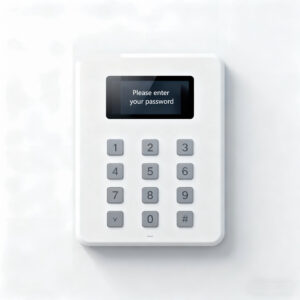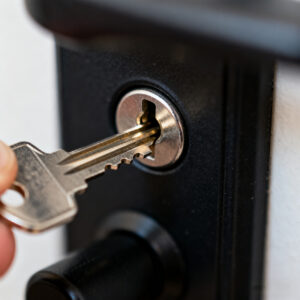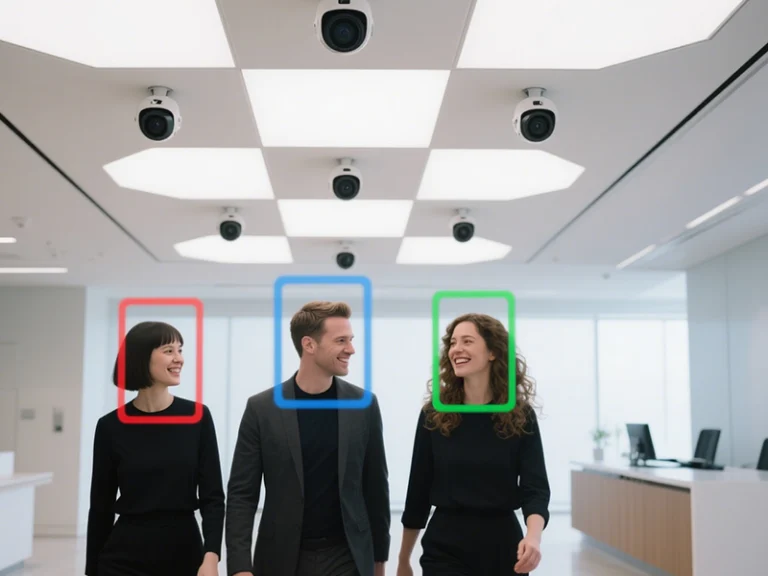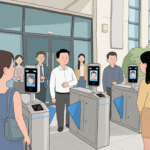This article presents a detailed comparative analysis of face access control versus traditional methods, exploring technology, applications, advantages, and limitations to help businesses make informed decisions for modern security solutions.
What is Face Access Control?
Face access control, also known as facial recognition access control, is a biometric system that identifies and authenticates individuals based on their unique facial features. Advanced AI algorithms analyze facial patterns, distances between facial landmarks, and other biometrics to ensure accurate recognition.
Key features
Face access control systems combine advanced biometric technology, AI algorithms, and smart hardware to offer a comprehensive security solution. Their key features include:
1. High Accuracy Facial Recognition
Uses deep learning algorithms to analyze unique facial landmarks such as the distance between eyes, nose shape, and jawline.
Minimizes false positives and false negatives, ensuring only authorized personnel are granted access.
Works reliably under varying lighting conditions and angles.
2. Touchless Authentication
Users can enter secure areas without touching any device, reducing the risk of spreading germs.
Ideal for healthcare, laboratories, schools, and high-traffic public facilities.
3. Rapid Access and High Throughput
Capable of processing dozens of individuals per minute, significantly faster than manual verification or card swipes.
Reduces waiting times at entry points and improves operational efficiency in offices, factories, and campuses.
4. Multi-Level Security and Permissions
Supports role-based access control, allowing different permission levels for employees, contractors, and visitors.
Can be configured to restrict access to sensitive areas, server rooms, or restricted zones.
5. Integration with Attendance and Management Systems
Can link seamlessly with employee attendance tracking software such as HFIMS.
Automatically records entry and exit times for workforce management, payroll calculation, and reporting.
6. Scalability for Large Organizations
Easily accommodates hundreds or thousands of users without issuing physical credentials.
Supports centralized management of multiple locations from a single platform.
7. Advanced Analytics and Reporting
Generates real-time access logs, alerts for unauthorized attempts, and historical data for security audits.
Can integrate with surveillance systems for enhanced monitoring and incident response.
8. High Security Against Spoofing
Uses liveness detection technology to prevent access through photos, videos, or masks.
Ensures biometric security is robust against modern spoofing attempts.
9. Flexible Deployment Options
Supports cloud-based, on-premises, or hybrid deployment.
Compatible with mobile devices, desktop systems, and integrated smart building solutions.
10. User-Friendly Interface
Traditional Access Control Methods
Traditional access control methods have been widely used for decades and include:
Keycards / RFID Cards: Users swipe or tap cards to gain access.
PIN Codes: Users enter a numerical code to unlock doors.
Mechanical Locks and Keys: Physical keys are used to secure doors.
Security Guards: Manual verification of identities at checkpoints.
While these methods can provide basic security, they come with notable limitations:
Susceptible to Theft or Loss: Cards and keys can be lost, stolen, or duplicated.
Human Error: PIN codes can be shared or forgotten; security personnel may make mistakes.
Limited Automation: Traditional methods often require manual management, making large-scale implementation inefficient.
Minimal Integration: Usually standalone systems without connection to modern building management or attendance tracking.
Despite these drawbacks, traditional methods remain popular in small businesses or low-security environments due to their low initial cost and simplicity.


Comparative Analysis: Face Access Control vs. Traditional Methods
| Feature | Kiểm soát truy cập bằng khuôn mặt | Traditional Methods |
|---|---|---|
| Security Level | High – biometric authentication prevents duplication | Medium – keys, cards, or PINs can be lost or shared |
| User Convenience | High – touchless, fast, and intuitive | Medium – requires physical tokens or memorized codes |
| Hội nhập | Excellent – can connect with attendance, mobile apps, and smart systems | Limited – mostly standalone without software integration |
| Maintenance | Low – mainly software updates and occasional hardware checks | Medium – card/key replacement and code management required |
| Khả năng mở rộng | Easy – add new users digitally | Harder – requires issuing new keys/cards manually |
| Vệ sinh | Excellent – no physical contact | Poor – touchpoints like keypads and cards |
| Trị giá | Higher upfront investment | Lower initial cost, but hidden costs can accumulate over time |
| Monitoring & Reporting | Advanced – real-time tracking and analytics available | Minimal – mostly manual logs or basic electronic records |
Advantages of Face Access Control Systems
1. Enhanced Security
Facial recognition technology ensures only authorized individuals can access sensitive areas, reducing theft, fraud, and unauthorized entries.
2. Operational Efficiency
Fast and automated authentication reduces waiting time at entry points and frees up security staff.
3. Integration with Attendance Systems
Automatically tracks employee attendance, eliminating manual timesheets and improving workforce management.
4. Hygienic Access
Touchless authentication is crucial for healthcare, laboratories, and public facilities.
5. Advanced Analytics
Modern systems can generate detailed reports, detect anomalies, and integrate with CCTV for real-time monitoring.
Limitations of Traditional Access Control
1. Security Vulnerabilities
Keys, cards, and PINs can be lost, stolen, or shared.
2. Time-Consuming Management
Manual issuance of cards, keys, or codes consumes administrative resources.
3. Limited Integration
Many traditional systems cannot connect to modern digital management tools.
4. Scalability Challenges
Adding or removing users often requires physical updates to hardware.
5. Touchpoints Risk
Physical interaction with keypads or cards can spread germs and increase hygiene concerns.
Applications Across Industries
Face access control systems are widely adopted in:
Corporate Offices: Secures buildings, server rooms, and restricted areas.
Healthcare Facilities: Protects sensitive zones and reduces contamination risk.
Education: Streamlines attendance tracking and campus access for students and staff.
Manufacturing & Warehouses: Controls access to production zones and integrates with workforce management.
Government & Critical Infrastructure: Ensures high-security standards and real-time monitoring.
Traditional methods may still be suitable for small businesses or temporary sites, but they are increasingly replaced by biometric solutions due to enhanced security, efficiency, and scalability.
Future Trends in Access Control
AI-Powered Recognition: Continuous improvements in AI and machine learning increase accuracy and speed.
Multi-Factor Authentication: Combining facial recognition with mobile apps or RFID cards for enhanced security.
Cloud-Based Access Management: Centralized management of multiple locations from a single platform.
Integration with IoT and Smart Buildings: Face access control can trigger lights, HVAC, and alarms automatically for optimized building management.
Mobile and Remote Access: Users can gain secure access through mobile devices using facial verification.
Phần kết luận
While traditional access control methods have been reliable for decades, face access control systems provide a modern, secure, and efficient solution for today’s complex security challenges. Organizations seeking to improve security, streamline operations, and adopt future-proof technology should consider investing in facial recognition access control systems.
By transitioning to face access control, businesses not only safeguard their premises but also leverage smart, AI-driven solutions that enhance overall operational efficiency.
Liên hệ chúng tôi
We would love to speak with you.
Feel free to reach out using the below details.







